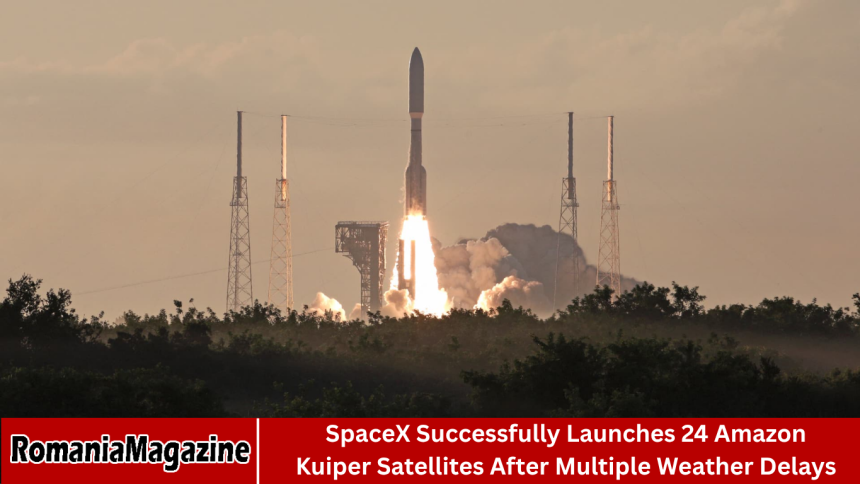In a major milestone for the future of global internet connectivity, SpaceX successfully launched 24 Amazon Kuiper satellites into orbit following several days of weather-related delays. This mission represents a significant step forward for Project Kuiper.
- The Mission: From Delays to Triumph
- Amazon’s Project Kuiper: Building a Global Internet Network
- Weather Challenges and the Importance of Launch Timing
- SpaceX and Amazon: Rivals Turned Partners
- The Broader Context: The Race for Satellite Internet Supremacy
- Technical Highlights of the Launch
- The Economic and Social Impact
- Environmental Considerations and Space Sustainability
- Looking Ahead: The Future of Project Kuiper
- Frequently Asked Question
- What is Amazon’s Project Kuiper?
- How many satellites were launched in this mission?
- Why was the launch delayed?
- Why did Amazon use SpaceX for this launch if they are competitors?
- How will Project Kuiper differ from SpaceX’s Starlink?
- When will Amazon’s satellite internet service be available?
- Are there environmental concerns about launching so many satellites?
- Conclusion
Amazon’s ambitious plan to build a constellation of satellites designed to deliver affordable, high-speed broadband access to underserved and remote areas worldwide. After facing unpredictable weather that grounded earlier launch attempts.
The successful deployment of these satellites marks one of the most crucial phases in Amazon’s multi-billion-dollar initiative to compete directly with SpaceX’s Starlink, as the race for space-based internet supremacy intensifies.
More Read: Apple TV+ Rebrands as Apple TV, Unveiling a Fresh and Vibrant New Identity
The Mission: From Delays to Triumph
The SpaceX Falcon 9 rocket carrying 24 Amazon Kuiper satellites finally blasted off after days of delay caused by adverse weather conditions over Florida’s Space Coast. The mission, named KuiperSat-3, is part of a larger collaboration between Amazon and SpaceX.
Wherein SpaceX will conduct multiple launches to help Amazon deploy thousands of Kuiper satellites over the next few years. Initially scheduled for earlier in the week, the launch had been postponed several times due to thunderstorms and high-altitude winds that made conditions unsafe for liftoff.
Patience paid off as SpaceX engineers and meteorologists waited for the optimal launch window. Once the weather cleared, the Falcon 9 rocket soared into the night sky, illuminating the Atlantic horizon in a stunning display of technology and precision.
After a flawless ascent, the rocket’s first stage booster executed a textbook landing on the “Just Read the Instructions” droneship stationed in the Atlantic Ocean—marking yet another recovery success in SpaceX’s ever-growing list of reusable rocket triumphs.
Amazon’s Project Kuiper: Building a Global Internet Network
Project Kuiper is Amazon’s answer to SpaceX’s Starlink, designed to provide high-speed, low-latency internet to users around the globe. The initiative aims to deploy a constellation of over 3,200 satellites in low Earth orbit (LEO) to bridge the digital divide, particularly in rural.
And remote communities where traditional broadband infrastructure is either unavailable or prohibitively expensive. Amazon’s vision for Project Kuiper extends beyond just internet access. The company intends to integrate the service into its existing ecosystem of devices.
Such as Echo smart speakers, Fire tablets, and AWS cloud platforms, effectively merging satellite internet with the company’s broader technological infrastructure.
This latest launch of 24 satellites represents a critical step toward the operational phase of Kuiper, enabling Amazon to begin testing connectivity, latency, and performance metrics in real-world conditions.
Weather Challenges and the Importance of Launch Timing
Space launches are notoriously sensitive to weather conditions, especially in regions like Florida where the climate can change rapidly. High winds, lightning, and thick cloud cover can disrupt countdowns or even damage sensitive equipment.
For this mission, meteorologists tracked several low-pressure systems hovering over the Gulf of Mexico and the Atlantic, causing uncertainty in the launch schedule. Each delay forced teams to reanalyze the trajectory, payload integrity, and safety parameters.
According to SpaceX’s launch director, the decision to delay was essential to ensure mission success. “Safety and precision come first,” he noted during a press briefing. “It’s always better to wait for the right conditions than to risk the payload or the vehicle.”
Once the weather window opened, conditions were nearly perfect, allowing SpaceX to conduct a smooth launch and payload deployment sequence that reaffirmed the reliability of its Falcon 9 platform.
SpaceX and Amazon: Rivals Turned Partners
At first glance, the partnership between SpaceX and Amazon seems unusual—after all, SpaceX’s Starlink and Amazon’s Kuiper are direct competitors in the satellite broadband space. Yet, this collaboration underscores a fascinating reality of the modern space industry: cooperation and competition often coexist.
Amazon has contracts with multiple launch providers, including United Launch Alliance (ULA), Blue Origin, and Arianespace, to deploy its full Kuiper constellation. However, delays in rocket development, particularly with Blue Origin’s New Glenn and ULA’s Vulcan Centaur.
Prompted Amazon to turn to SpaceX—a move that highlights SpaceX’s unmatched reliability and readiness in the commercial launch sector. This cooperation also demonstrates SpaceX’s pragmatic approach.
Despite competing with Kuiper in the broadband market, SpaceX continues to offer its launch services to any client willing to pay. This flexibility has positioned the company as the go-to partner for satellite deployment, even among rivals.
The Broader Context: The Race for Satellite Internet Supremacy
The satellite internet industry has rapidly evolved into one of the most competitive arenas in modern technology. SpaceX’s Starlink, which already operates over 6,000 satellites in orbit and serves millions of customers globally, currently leads the market.
Amazon’s Project Kuiper, though several years behind, has significant financial backing and the advantage of Amazon’s global infrastructure and consumer reach. Other competitors, such as OneWeb, Telesat, and China’s Guowang, are also racing to secure orbital real estate and regulatory permissions.
The challenge lies not just in launching satellites but in building efficient ground networks, managing interference, and ensuring affordability for end users. Amazon’s approach focuses heavily on leveraging its supply chain expertise, cloud computing (AWS).
And retail network to deliver an integrated internet service that aligns with its broader business model. If successful, Project Kuiper could potentially power Amazon’s next generation of connected devices and services, creating a seamless digital ecosystem.
Technical Highlights of the Launch
The Falcon 9 rocket used for this mission featured several key technical achievements:
- Payload Capacity: The rocket carried 24 satellites weighing roughly 18,000 kilograms in total.
- Orbit Altitude: The satellites were deployed into low Earth orbit (LEO), approximately 500 kilometers above the surface.
- Deployment Sequence: The satellites were released in multiple phases to ensure safe separation and minimize the risk of collision.
- Booster Reusability: The first stage booster completed its ninth successful landing, showcasing SpaceX’s continued mastery of rocket reusability.
- Mission Duration: From liftoff to payload separation, the mission lasted approximately one hour and fifteen minutes.
Each Kuiper satellite is equipped with advanced phased-array antennas and solar arrays that unfold after deployment, allowing them to communicate efficiently with ground terminals and relay broadband data across vast distances.
The Economic and Social Impact
The success of this launch has implications far beyond the space industry. By advancing Project Kuiper’s deployment, Amazon moves closer to its goal of bringing affordable internet access to hundreds of millions of people who currently lack connectivity.
According to the International Telecommunication Union (ITU), nearly 2.6 billion people worldwide still do not have access to the internet. Projects like Kuiper and Starlink aim to close that gap by using constellations of satellites to beam internet directly to ground stations or user terminals.
Beyond individual consumers, this technology could benefit schools, healthcare providers, small businesses, emergency responders, and even government agencies in remote or conflict-affected regions.
The ripple effects of global internet access could stimulate economic development, digital education, and innovation on a scale comparable to the introduction of mobile phones two decades ago.
Environmental Considerations and Space Sustainability
With the rise of satellite constellations comes growing concern over space debris and orbital congestion. Each new batch of satellites increases the risk of collisions that could create dangerous debris fields in Earth’s orbit.
Amazon has emphasized that its Kuiper satellites are designed with responsible deorbiting mechanisms, ensuring that each satellite will automatically deorbit and burn up in Earth’s atmosphere at the end of its operational life.
Additionally, Kuiper satellites are equipped with onboard propulsion systems to maneuver away from potential collision paths. SpaceX, too, has implemented similar safety measures with its Starlink satellites.
Both companies are working closely with agencies like NASA and the U.S. Space Command to ensure sustainable orbital management. Still, as thousands more satellites are launched over the next decade, the need for international space traffic regulation will become increasingly urgent.
Looking Ahead: The Future of Project Kuiper
With this successful launch, Amazon is on track to begin beta testing Project Kuiper’s broadband service in 2026. The company has already begun constructing ground infrastructure and manufacturing facilities in Kirkland, Washington, to scale up satellite production.
Amazon has committed over $10 billion to the Kuiper project, with plans to deploy the full constellation of 3,236 satellites within the next few years. The ultimate goal is to offer seamless, affordable, and high-speed internet service worldwide, rivaling existing providers both in orbit and on the ground.
The collaboration with SpaceX marks only the beginning of what promises to be a transformative decade for both companies and for global communication as a whole.
Frequently Asked Question
What is Amazon’s Project Kuiper?
Project Kuiper is Amazon’s satellite internet initiative aimed at providing affordable, high-speed broadband service to underserved regions using a constellation of over 3,200 satellites in low Earth orbit.
How many satellites were launched in this mission?
SpaceX launched 24 Amazon Kuiper satellites aboard a Falcon 9 rocket, marking a significant step in Amazon’s efforts to build its global satellite network.
Why was the launch delayed?
The launch was postponed several times due to unfavorable weather conditions—including high winds and thunderstorms—over Florida’s Space Coast, which posed safety risks for liftoff.
Why did Amazon use SpaceX for this launch if they are competitors?
While SpaceX’s Starlink competes with Amazon’s Kuiper in the broadband market, SpaceX also provides commercial launch services. Amazon contracted SpaceX due to its proven reliability and available launch capacity.
How will Project Kuiper differ from SpaceX’s Starlink?
Project Kuiper will integrate closely with Amazon’s ecosystem, including AWS Cloud, Alexa devices, and retail platforms, offering a more connected experience across multiple technologies.
When will Amazon’s satellite internet service be available?
Amazon plans to begin beta testing Project Kuiper’s services by 2026, following the deployment of additional satellites and successful system testing.
Are there environmental concerns about launching so many satellites?
Yes, there are growing concerns about space debris and orbital congestion. However, Amazon has designed Kuiper satellites with self-deorbiting mechanisms and collaborates with regulatory agencies to ensure sustainable operations.
Conclusion
The successful launch of 24 Amazon Kuiper satellites by SpaceX represents more than just another rocket mission—it is a pivotal chapter in humanity’s pursuit of global connectivity. Despite weather setbacks, SpaceX’s reliability and precision once again shone through, delivering Amazon’s satellites into orbit with remarkable efficiency.
For Amazon, this launch propels Project Kuiper closer to operational readiness, setting the stage for a new era in internet accessibility. For SpaceX, it’s yet another testament to its leadership in space technology and its unique role as both competitor and enabler in the rapidly expanding space economy.









